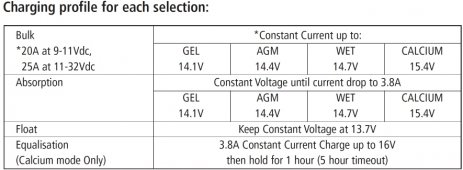Mainly as a learning experience and as a foot in the door to LiFePO4, (with the view of building an off-grid residence on my property in the future), I'm upgrading my campervan from a 130Ah AGM to a 12v 100Ah LiFePO4 battery, (new Ganfeng cells, Daly 4S 12V 100Ah BMS)... I've purchased a Victron 75/15 MMPT solar charger, Victron IP65 15A mains charger, and a 500A SmartShunt, being a cheapskate I'm reluctant to spend the money on a Victron DC-DC charger also...
I have an (Aussie brand?) Projecta 25A DC-DC & solar charger that I've been using on AGM batteries in my campervan for a few years:
https://www.projecta.com.au/ts16492...Group/1/IDC25+Instruction+Manual+12.03.20.pdf
I'm thinking it would probably be ok to use this intelligent? non-LiFePO4 DC-DC charger set to the Gel profile to charge the LiFePO4 from my alternator:

The GEL Profile is 14.1V Bulk/ABS, 13.7V Float, I "think" this would probably be ok but I'm not chasing a maximum capacity or charge rate, I'm more interested in maximizing the life of the battery... With the research I've done I'll probably set my Victron solar and mains chargers at around 13.8V ABS, 13.4V Storage/float...
An idea that crossed my mind, with the view of being kind to the battery, was to use the AGM profile on the DC-DC charger and add a large power diode in the charge cable to introduce a 0.7V voltage-drop, maybe something like a 70 Amp 70HF120, so in theory the ABS voltage would be dropped to 13.7V, and float to 13V...
I'm wondering if any of the resident experts here have an opinion on this diode idea?, any comments are appreciated ...
Thanks
I have an (Aussie brand?) Projecta 25A DC-DC & solar charger that I've been using on AGM batteries in my campervan for a few years:
https://www.projecta.com.au/ts16492...Group/1/IDC25+Instruction+Manual+12.03.20.pdf
I'm thinking it would probably be ok to use this intelligent? non-LiFePO4 DC-DC charger set to the Gel profile to charge the LiFePO4 from my alternator:

The GEL Profile is 14.1V Bulk/ABS, 13.7V Float, I "think" this would probably be ok but I'm not chasing a maximum capacity or charge rate, I'm more interested in maximizing the life of the battery... With the research I've done I'll probably set my Victron solar and mains chargers at around 13.8V ABS, 13.4V Storage/float...
An idea that crossed my mind, with the view of being kind to the battery, was to use the AGM profile on the DC-DC charger and add a large power diode in the charge cable to introduce a 0.7V voltage-drop, maybe something like a 70 Amp 70HF120, so in theory the ABS voltage would be dropped to 13.7V, and float to 13V...
I'm wondering if any of the resident experts here have an opinion on this diode idea?, any comments are appreciated ...
Thanks
Last edited:


